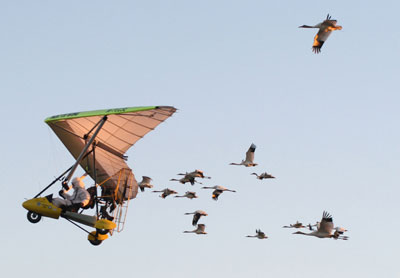
 Seven whooping cranes flew over Georgia on Tuesday following an ultralight aircraft on a migration route to Florida.
Seven whooping cranes flew over Georgia on Tuesday following an ultralight aircraft on a migration route to Florida.
The birds flew 117 miles from Pike County, Ala., to Decatur County in south Georgia on a leg of a 61-day journey that started in Wisconsin. The whooping cranes spent the night Tuesday in a field near Climax, GA, and were headed to Leon County on Wednesday, just 33 miles south.
The flight is part of a 14-year effort to reestablish an eastern migratory whooping crane by guiding the birds to places where they will hopefully be safe from predators, including human hunters.
Boosted by wind, whooping cranes and ultralight covered 117 miles from Pike County, AL, to Decatur County in 2 hours and 20 minutes.
Currently 97 whooping cranes are flying from Wisconsin to Florida on their own, with the ultralight program being only one strategy of re-introducing the birds to the wild from a captive breeding population of about 140 birds.
Over the last 35 years a series of reintroduction projects have been developed to establish new wild whooping crane populations. The projects have had varying success, but as each project builds on previous attempts we are learning what techniques work most effectively. Today, as a result of years of dedication, a second Whooping Crane population numbering over 100 birds migrates through the eastern United States. In 2010 two chicks successfully fledged in this population – a symbol of hope for the future of Whooping Crane conservation.

In one of the reintroduction projects, whooping crane eggs from captive breeding centers are hatched at the Patuxent Wildlife Research Center, where the chicks are first exposed to ultralight aircraft and learn to follow the ultralights on the ground. As they grow older, the chicks are transported to the White River Marsh State Wildlife Area in Wisconsin, where they spend the summer learning to fly behind the ultralights. In the fall, the chicks follow the ultralights to the Chassahowitzka and St. Marks National Wildlife Refuges along Florida’s Gulf Coast. A project partner, Operation Migration, leads the young Whooping Cranes on migration with the ultralight aircraft.
Follow the path of the migrating birds being led by ultralight plane – Operation Migration blog
The cranes learn the ~1,200 mile migration route during their first trip south in the fall, and are able to make the return journey on their own the following spring. In subsequent years, the cranes continue to migrate on their own. Biologists from the International Crane Foundation and the U.S. Fish and Wildlife Service track and monitor the cranes year-round after the birds’ first migration south.
For more information on the International Crane Foundation’s efforts to increase the whooping crane population, please visit the ICF website.
Whooping Crane Fun Facts
Scientific Name: Grus americana
Height: 5 ft; Wingspan: 7-8 ft
Field Marks: Adults – red patch on forehead, black mustache and legs, black wing tips visible in flight; juveniles – cinnamon-brown feathers
Population: ~ 599 (captive and wild)
Diet: Plant tubers, blue crabs, small mammals, amphibians, reptiles, insects
Vocalizations: Loud, rattling kar-r-r-o-o-o.
What threatens whooping cranes
Threats: Loss or deterioration of critical wetland habitat (including reduced fresh water at wintering grounds in Texas), low genetic diversity, power line collisions, predation, disturbance at nest sites and illegal shooting.





Be the first to comment